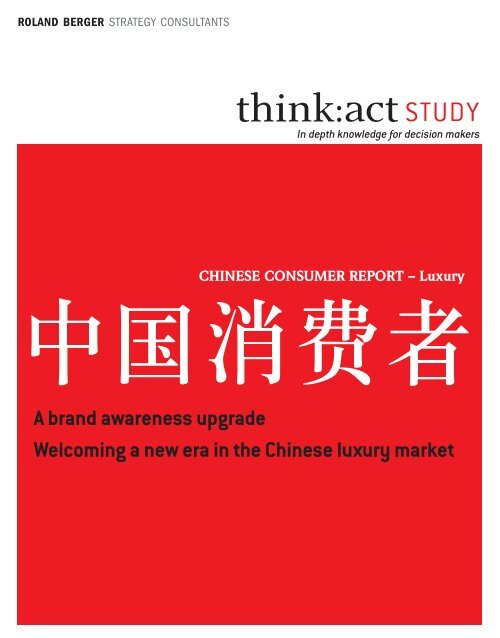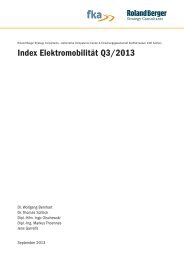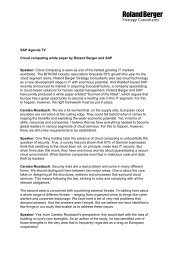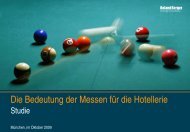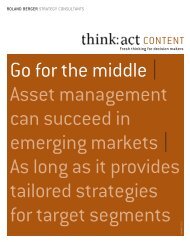Chinese Consumer Report 2012 - Luxury - Roland Berger
Chinese Consumer Report 2012 - Luxury - Roland Berger
Chinese Consumer Report 2012 - Luxury - Roland Berger
Create successful ePaper yourself
Turn your PDF publications into a flip-book with our unique Google optimized e-Paper software.
Have you ever tried to buy some unfamiliar brands?Buy unfamiliar brands[mentioned %]Never1 out of 6 or 71 out of 4 or 51 out of 1 or 2Almost every timeluxury goodsclothingChannel predetermination[mentioned %]Q: Would you buy some unfamiliar brands?Q: Do you decide on the brand and product categorybefore purchasing?Source: 2011 <strong>Roland</strong> <strong>Berger</strong>’s <strong>Chinese</strong> <strong>Luxury</strong> <strong>Consumer</strong>s Survey (n=1,393), accurate, <strong>Roland</strong> <strong>Berger</strong> AnalysisOn-site decision factorsDeterminebrands andproductsDeterminespecific brandDeterminespecific productcategoryOn-site decisionluxury clothing skin care mobilegoodsphone<strong>Chinese</strong> luxury consumers are not confidentabout the credibility of the information theyreceive. Cautious purchasing behavior isthe result. They rarely buy unknown brandsand do no buy on the spur of the moment.Purchases are made only after very thoroughconsideration.Similarly, consumers buying skin careproducts and mobile phones rarely makepurchases on impulse or before lengthyconsideration. For makers of luxury goods thisis an important insight: the competitive battlebegins at the earliest stage of the purchasingprocess.Reasons for buying the product[mentioned %]Reasons for not buying the product[mentioned %]On-site decisionsBrandDesignQualityPriceluxury goodsclothingQ: Which factor do you consider first when choosingthe products?Don’t know the brandThe brand culture/style doesn’t suit meThe price is too highOthersSource: 2011 <strong>Roland</strong> <strong>Berger</strong>’s <strong>Chinese</strong> <strong>Luxury</strong> <strong>Consumer</strong>s Survey (n=1,393), accurate, <strong>Roland</strong> <strong>Berger</strong> analysisFinal purchase (taking high-end jewelry as an example)luxury goodsQ: What kinds of brands won’t you buy?clothingNothing is more important than brand for<strong>Chinese</strong> consumers when purchasing luxurygoods in stores. Brand is more important thandesign, quality or price. When affordabilityis not an issue, <strong>Chinese</strong> consumers tend toupgrade to top-tier brands.Whereas it is common for consumers in moremature markets to reject a brand because it"doesn't suit them", this rarely occurs in China.Brands are rejected in China because they arenot known.market share [%; 2010]Despite brand proliferation, the market isrelatively concentrated due to the presenceof certain more established brands. Theseestablished brands enjoy high brandawareness.Upgrading brand awarenessoperating history in ChinaSource: 2011 <strong>Roland</strong> <strong>Berger</strong>’s <strong>Chinese</strong> <strong>Luxury</strong> <strong>Consumer</strong>s Survey (n=1,393), accurate, <strong>Roland</strong> <strong>Berger</strong> analysisbrand awareness [%]<strong>Roland</strong> <strong>Berger</strong> believes that <strong>Chinese</strong> luxurygoods consumers are becoming moresophisticated, evolving into buyers thatpurchase goods that make them feel good andgive them a certain sense of self-satisfaction.6
These purchases are not made to show off. Asbuyers become more egoistic and rational wepredict that brand preference and recognitionwill be increasingly important in the consumerdecision-making process.In the future, the question of "whether a brandsuits me" will become a more importantfactor for <strong>Chinese</strong> consumers when decidingto buy a luxury good. The rise of consumersthat belong to the archetype groups WealthySecond Generation, Ambitious Elites and StylishWhite Collars will go hand-in-glove with moreegoistic and independent purchasing decisions.Therefore, the battle of brand preference andrecognition of luxury goods will ensure as thedrive for increased brand awareness takes effect.The luxury car market provides a goodexample of how makers of luxury goods canposition themselves in relation to the intrinsicqualities and associations that the brandwishes to project to <strong>Chinese</strong> luxury goodsconsumers. The brand positioning of the fourluxury car brands are significantly different.The brand positioning has been made basedon the uniqueness of the <strong>Chinese</strong> marketwithin the larger framework of global brands.The four brands center around the values"distinguished", "beautiful", "exquisite","credible", "advanced" and "dynamic". Eachbrand has a focus on this first level and furtherdifferentiates itself from its competitors onthe second level. Take "distinguished" as anexample: Whereas Mercedes Benz is linked todistinguished origin, BMW is linked to noblesports, and Lexus with implicit style. Thepairings in the example of "beautiful" are alsotelling: Audi—fashion beauty, Benz—classicbeauty, BMW— artistic beauty, and Lexus—purity and simplicity beauty.The evolution of the psychological demand of <strong>Chinese</strong> luxury consumersgroup affiliation(generally recognize)Source: <strong>Roland</strong> <strong>Berger</strong> analysisFirst level Second-level values MB BMW Audi LexusDistinguishedBeautifulExquisiteCredibleAdvancedDynamicappreciation(products, service, existence)·compare with others· lacking taste andemotional demandshow off(luxury, status)distinguishedclassic (eternal)Implicittasteful (aesthetic, elegant)AttractiveSimple (pure)exquisite (serious)caringhigh qualityresponsibility (credible)advanced technology(design model)InnovativeOriginalDynamicYoungAthletic·egoistic·rationalindividuality(taste, culture)Commentary:Different brand positioning and translation of deluxe car brandsIn the past:·Characteristics of <strong>Chinese</strong> luxury market-- <strong>Consumer</strong>s had a relatively low level ofeducation-- <strong>Consumer</strong>s valued brand awareness andpopularity the most· Brand preference of <strong>Chinese</strong> luxuryconsumers--Social circle--Befitting status and occasionIn the future:·Rational demand-- Satisfaction of rational needs, such asquality and comfort--Recognition of value for money·Emotional aspect--Focus on “whether the brand suits me”-- Pay more attention to personal taste,culture and modern valuesPleasantSource: <strong>Roland</strong> <strong>Berger</strong> analysis7
Winning in the luxury marketComparison of consumers' level of involvement in the decision making process indifferent product groupsInformation seeking activity level[mentioned %]OftenSometimesNeverluxury clothing skin care mobilegoodsphoneThree characteristics of active information seekersluxury clothing skin care mobilegoodsphoneSource: 2011 <strong>Roland</strong> <strong>Berger</strong>’s <strong>Chinese</strong> <strong>Luxury</strong> <strong>Consumer</strong>s Survey (n=1,393), Industry Interviews; <strong>Roland</strong> <strong>Berger</strong> AnalysisCharacteristics of active information seekersThe number of brandsrecognized with/withoutpromptingOften activelyseek informationSometimes activelyseek informationNever activelyseek informationInformation seekingchannelsMagazinesPhysical storesProfessionalonline channelsof luxury goodsConsult othersOfficial brandwebsitesOnline searchE-commercewebsitesNumber recognized without promptingNumber recognized with promptingNumber of brands recognizedwithout prompting[mentioned %]Reason for absolutely notbuying a particular brandDon’t knowthe brandBrand style/culture doesn’tsuit mePrice is toohighOthersOften activelyseek informationSource: 2011 <strong>Roland</strong> <strong>Berger</strong>’s <strong>Chinese</strong> luxury consumers survey<strong>Luxury</strong> <strong>Consumer</strong>s Survey (n=13931,393), industryinterviews; <strong>Roland</strong> <strong>Berger</strong> analysisSometimes activelyseek informationNever activelyseek information1) They are relatively less dependent on social networks;2) Though active in getting information, they know a limited number of brands. They knowmore brands than other consumers with capacity to increase the number of knownbrands;3) They believe the important factor of brand should be whether the brand suits themrather than the brand's popularity.Active information seekers, who are also highly receptive of market information, account for 14%of luxury product consumers. Educating this group has the following benefits:1) Education cost is very low as they actively seek information from relatively fixedinformation channels;2) Their social network can be leveraged to influence other consumers.<strong>Roland</strong> <strong>Berger</strong> experts believe that <strong>Chinese</strong>luxury goods consumers are upgrading fromsimple brand awareness to a higher level thatis accompanied with greater expectationsfrom brands and greater demands. Brandsthat are capable of recognizing the shift inconsumer sentiment will be more likely toachieve success in the luxury market, outmaneuveringtheir competitors. Strategiesneed to be devised that cover marketing, salesnetworking and product portfolio development.Companies that accomplish them will not onlyhave a competitive advantage; they may evendisrupt market patterns.Finding the brand ambassadorIt is important for luxury brands to find peoplewho hold influence in desired consumer circles– these people act as brand ambassadors.We observe from our analysis that activeinformation seekers – these people are alsohighly receptive to market information –account for 14% of luxury product consumers.This is about the same percentage as thosewho consume relatively complex productssuch as skin care and mobile phones.Combined, this indicates that a significantnumber of consumers involve themselvesheavily in purchasing process considerations– at least with respect to these product groups.An earlier analysis conducted by <strong>Roland</strong><strong>Berger</strong> experts also revealed that a higherproportion of active information seekers werefound to exist among Stylish White Collars,Ambitious Elites and the Wealthy SecondGeneration luxury consumer archetypes, thanelsewhere.Active information seekers display three keycharacteristics: For those deeply involved inthe purchasing process, the thought that a"brand's style/culture doesn't suit me" is nowmore likely to be the primary reason for not8
purchasing a product – and no longer "I don'tknow a brand."For active information seekers it is vital thatbrands appear frequently in informationchannels. Not only does this reinforcerecognition, it also enables preferences tobe formed. Brands that wish to speak to thissegment of the market must intensify theirmarketing initiatives in magazines and onlinechannels. More importantly, they must winthe active support of active informationseeks. It is critical for luxury goods makers tostrengthen the relationship and increase thelevel of intimacy between the brand and activeinformation seekers through events and VIPpublications, allowing them to take part in thebrand development process through word-ofmouth.Setting up a global store network3) About 10% of the consumers whobuy luxury goods purchase thesegoods at the request of relativesand friendsGiven the interconnectedness betweendomestic and international purchases,physical stores of luxury brands in Chinashould not just be points of sale. They shouldrather view themselves as display windows,highlighting to consumers the potential ofworldwide sales.Considering that many consumers examineproducts at home and then shop abroad,stores in China should become the marketingground for products sold only abroad. As wellas carrying SKUs that drive sales volume,stores in China should also display designsand products that are available in Hong Kong,Singapore and Tokyo through the use ofproduct catalogs, leaflets and samples. At thesame time, stores abroad should be betterprepared to cater to <strong>Chinese</strong> demand.Sophisticated consumers demand servicesthat are consistently good. More and moreastute consumers expect and require"friendly", "professional" and "unpretentious"in-store services. These values should beclearly communicated with consistencyto ensure that the consumers' shoppingexperience is positive and maximized.To ensure that sales staff act in accordancewith the brand's intentions, more attentionneeds to be paid to store assessments.These should extend beyond the analysis ofsales figures and incorporate indicators suchas store image, number of store visits andconsumer satisfaction rates.Many <strong>Chinese</strong> frequent luxury storesworldwide, especially in places close to homelike Hong Kong and Macao. According to asurvey <strong>Roland</strong> <strong>Berger</strong> conducted in 2011,over 50% of consumers purchased luxurygoods outside of mainland China in 2010.Nevertheless, the consumption patterninside and outside of mainland China isclosely related.<strong>Chinese</strong> consumers’ consumption behavior inside and outside China<strong>Chinese</strong> consumers’ luxuryconsumption location<strong>Chinese</strong> consumers’ purchasing behavior abroadOur survey shows that:In ChinaAbroad1) Over 70% of consumers who buyluxury goods outside of mainlandChina have also bought productsfrom the same brand insidemainland China2) Over 20% of consumers who buyluxury goods outside of mainlandChina make their purchasingdecision when in mainland China% ofglobalsalesTotalMainlandChinaHong Kong,Macao andTaiwanOutsideGreaterChinaKnowing the brands throughothers’ recommendation orthrough retail outlets, leading tolow number of preferred brandsHigh price confirms the brandexclusivity, leading to cautiouspurchasesOften first time purchases ofsome brandsLeverage brand awarenessdeveloped in ChinaMore reasonable prices lead torather liberal purchase behaviorthat is based on developed brandawarenessRepeat purchase - about 70%of the consumers abroad havemade purchases from respectivebrands in ChinaSource: 2011 <strong>Roland</strong> <strong>Berger</strong>’s <strong>Chinese</strong> <strong>Luxury</strong> <strong>Consumer</strong>s Survey (n=1,393), industry interviews; <strong>Roland</strong> <strong>Berger</strong> analysis9
<strong>Luxury</strong> market capacity in different tier cities<strong>Luxury</strong> market penetration and average spending indifferent tier citiesPopulation [million]Average spending[thousand/year]Penetration of luxurygoods: first-tier, secondtier,third-tier, fourth-tierNumber of citiesSource: 2011 <strong>Roland</strong> <strong>Berger</strong>’s <strong>Chinese</strong> <strong>Luxury</strong> <strong>Consumer</strong>s Survey (n=1,393), industry interviews; <strong>Roland</strong> <strong>Berger</strong> analysis58 key battlefield cities for <strong>Chinese</strong> luxury brand marketspending powerBattlefield forluxury goodsconsumer spending powerthird-tierTotal spending in luxury goodsin different tier cities[100 million]fourth-tierKey battlefield for luxury companiesfirst-tiersecond-tierSource: 2011 <strong>Roland</strong> <strong>Berger</strong>’s <strong>Chinese</strong> <strong>Luxury</strong> <strong>Consumer</strong>s Survey (n=1,393), China City Statistical Yearbook, NationalDevelopment and Reform Commission, Yearbook of China Retail Corporations in Chain; <strong>Roland</strong> <strong>Berger</strong> analysis#citySpending onluxury goodsPopulation (million)City <strong>Luxury</strong> brandpopulation consumerspopulationKey battlefieldcoverage#cityCitypopulationTargetconsumergroup ofluxury goodsSpending onluxury goodsBroaden the core market for marketingThere is untapped potential for sales in China'sluxury goods segment. Although most luxurycompanies have opened stores in China's firstand/or second-tier cities, buyers from thirdand fourth-tier cities account for nearly 40%of total sales. This proportion is expected tofurther increase in the future.<strong>Consumer</strong>s from second-tier cities havecontributed a higher percentage of sales thanthose from first-tier cities. <strong>Consumer</strong>s fromthird and fourth-tier cities together have alsocontributed a higher percentage than those infirst-tier cities.In our view, there are many key battlefieldcities for luxury companies in China. As itis unrealistic to cover all third and fourthtiercities, we have identified the key citiesof the luxury market through our proprietarymodel, which is based on spending power andeconomic scale.In this model, which follows the 80/20 rule,we aimed to cover the largest luxury goodsconsumer population with the fewest numberof cities. According to our model, 70% of luxurygoods consumers can be reached by covering58 cities. Leading international brands havenot yet reached this coverage level. In the nearfuture, the growth of China's luxury marketwill still be driven by store expansion frommultinational luxury companies.Low-tier market coverage by internationalluxury goods companies is still low butconsiderable market capacity exists fornetwork growth.The key question for international luxury brandsis how to effectively reach that large pool ofpotential buyers in third and fourth-tier cities.10
Beijing20/F, Tower A, Gateway Plaza, 18 Xia Guang Li, Dong San Huan North Road, Beijing, China, 100027 Tel :+86 10 8440 0088Shanghai23/F, Shanghai Kerry Centre, 1515 West Nanjing Road, Shanghai, China, 200040 Tel: +86 21 5298 6677Guangzhou10/F, 8 Linhe Zhong Road, Guangzhou, Guangdong, China, 510620 Tel: +86 20 2831 7508Hong Kong16/F, Nexxus Building, 41 Connaught Road, Central, Hong Kong Tel: +852 3757 9480Taipei37/F, Taipei 101 Tower, 7 Xinyi Road, Section 5, Taipei, Taiwan, 110 Tel: +886 2875 82835infochina@rolandberger.comwww.rolandberger.com.cn<strong>Roland</strong> <strong>Berger</strong> Strategy Consultants<strong>2012</strong>, all rights reserved


